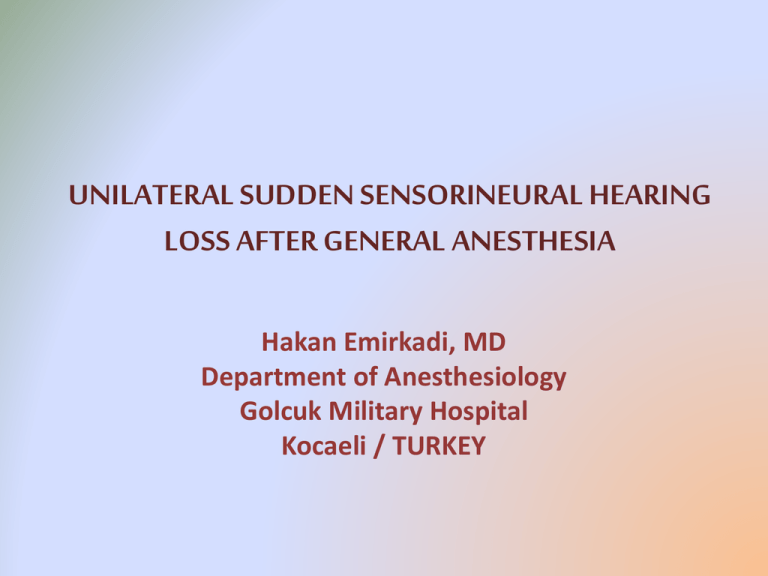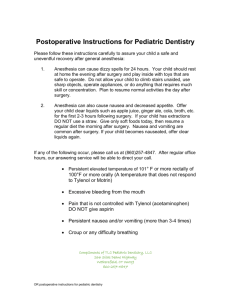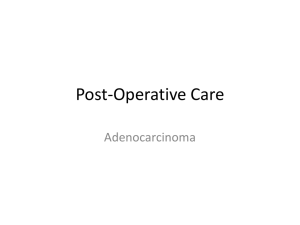PowerPoint Sunusu
advertisement

UNILATERAL SUDDEN SENSORINEURAL HEARING LOSS AFTER GENERAL ANESTHESIA Hakan Emirkadi, MD Department of Anesthesiology Golcuk Military Hospital Kocaeli / TURKEY Background-Sudden Sensorineural Hearing Loss 30 dB or more loss of at least three consequent audiometric frequencies occured within the last three days. 15.000 new cases are reported annually worldwide.1 1 Hughes GB, Freedman MA, Hamerkamp TJ et al: Sudden Sensorineural Hearing Loss. Otolaryngol Clin North Am 29: 393-405 Background-Sudden Sensorineural Hearing Loss 2 Incidence increases with age2 No consistence of sexual predominance No seasonal variation No geographical distribution Delleyn A (1944): Sudden complete or partial loss of function of the octavus system in apparently normal persons. Acta Otolaryngol (stoch) 32: 407-429 Background-Sudden Sensorineural Hearing Loss Possible causes are:3 viral infection vascular compromise disruption of cochlear membrane immunologic diseases otological tumors Only in 10% of cases of SSHI the causes can be identified 3 Anderson RG, Meyerhoff WL (1983): Sudden Sensorineural Hearing Loss. Otolaryngol Clin North Am 16: 189-194 Background-Sudden Sensorineural Hearing Loss Infections: Inflammatory process of the inner ear-Viral causes 70% herpes simplex virus Vascular: Intolerance to hypoxia after 30 mins. Permanent damage occurs Membrane Rupture: Rupture of the Reisner’s membrane Background- Diagnosis 1. Discover and avoid potential ototoxic drugs: Streptomycin, Acetyl salicilates, Gentamycin, etc 2. Control co-morbid metabolic diseases: DM, CVS diseases, etc 3. Detailed audiometry must be performed in all patients 4. Routine blood tests must be performed to rule out systemic and metabolic diseases 5. MR scans (if needed) to rule out cerebellopontine angle tumors and neurological lesions Case Report 36 year-old female septal deviation and external nasal deformity breast deformity Medical history lipoma excision (shoulder, general anesthesia, one year ago) No known allergy Heavy smoker Not receiving any kind of medication Case Report preoperative evaluation systemic examination Lab tests ECG chest x-ray blood tests were normal NORMAL !!! Case Report- ANESTHESIA Premedication: Midazolam 1.5 mg I.V Induction: Nitrous oxide, oxygen and remifentanyl Maintenance: Isoflurane and vecuronium bromide Case Report- ANESTHESIA Nasal surgery: ENT surgeon ; Breast reduction: Plastic surgeons. Dexamethasone 4 mg perioperatively Metoclopramide HCL 10mg advised by the Cefazoline sodium 1gr anesthesiologist Case Report- ANESTHESIA On the third hour of the surgery, Gentamicin 100mg I.V.: as a routine of plastic surgery. Total operative time was approximately five hours Case Report- ANESTHESIA Postoperatively: sefazoline sodium I.V. 3g/day paracetamol 1500 mg/day xylometazoline spray pethidine HCL pantoprazole HCL I.V. 80mg/day Case Report- Postoperative Postoperative 1st day: Tinnitus + Right hearing loss Physical examination was normal. Audiogram: Right sensorineural hearing loss (average 101 dB ) Case Report- Postoperative work-up Diagnostic work-up: Neurological consultation Lab tests CBC, creatinine, BUN, CRP, B12, folic acid Cranial MRI NORMAL !!! Case Report- Treatment Pentoxifylline 600mg b.i.d + Pentoxifylline 100mg I.V. in one hour Dextrane in isotonic NaCl solution 500cc IV in six hours Methylprednisolone sodium succinate 80mg IV Acetylsalicylic acid 100mg p.o. Acyclovir 250mg q.i.d IV Vitamin E 200IU Vitamin B1, B6, B12 complex 250mg b.i.d. Case Report- Postoperative Postoperative 2nd day: Hyperbaric O2 treatment was started on the postoperative second day and continued for 20 sessions Hearing level was monitored with serial audiograms on postoperative 3rd, 6th, 8th,13th and 24th days On postoperative third day pure tone air and bone conduction average in the right ear was 78dB and 63dB respectively Case Report- Postoperative Discharged on the postoperative sixth day During the six month follow-up, the air and the bone conduction averages recovered to 58dB and 50dB in lower frequencies Discussion SSHL after non-otologic surgery is a rare entity and is mostly reported in association with cardiac bypass surgery. Microemboli occluding internal auditory artery is the proposed underlying mechanism of SSHL associated with cardiac surgery.4 4 Walsted A, Andreassen UK, Berhelsen PG, Olesen A. Hearing Loss after cardiopulmonary bypass surgery. Eur Arch Otorhinolaryngol (2000) 257 :124–127 Discussion Nitrous oxide administration during the general anesthesia may cause rapid increase in the middle ear pressure up to 450 mm/Hg. This relatively high middle ear pressure may cause cochlear membrane breaks and perilymph fistula.5,6 5 Evan KE, Tavill MA, Goldberg AN, Silverstein H. Sudden sensorineural hearing loss after general anesthesia for nonotologic surgery. Laryngoscope 1997 Jun; 107(6):747-52. 6Segal S, Man A, Winerman I. Labyrinthine membrane rupture caused by elevated intratympanic pressure during general anesthesia. Am JOtol 1984;5(4):308-10. Discussion In our case, perioperative administration of single dose gentamicin reminded us ototoxicity. But after detailed evaluation of clinical signs and occurrence pattern we decided that aminoglycoside ototoxicity is debatable to be the final diagnosis. Aminoglycoside ototoxicity is irreversible and auditory toxicity occurs as a result of the accumulation of aminoglycosides in the perilymph of the inner ear with subsequent damage of the sensory cells of the organ of Corti. Cochlear damage is usually permanent since cochlear hair cells do not regenerate. In this case there are some points of interest: If the hearing loss is due to ototoxicity, even minor doses of aminoglycosides must be avoided We managed this case as postoperative SSHL since characteristic features of aminoglycoside ototoxicity were missing Although improvement in hearing level was not satisfactory in our case, we believe that early detection and prompt evaluation of hearing loss may improve outcome despite the uncertainty in the etiology, the management and the prognosis






